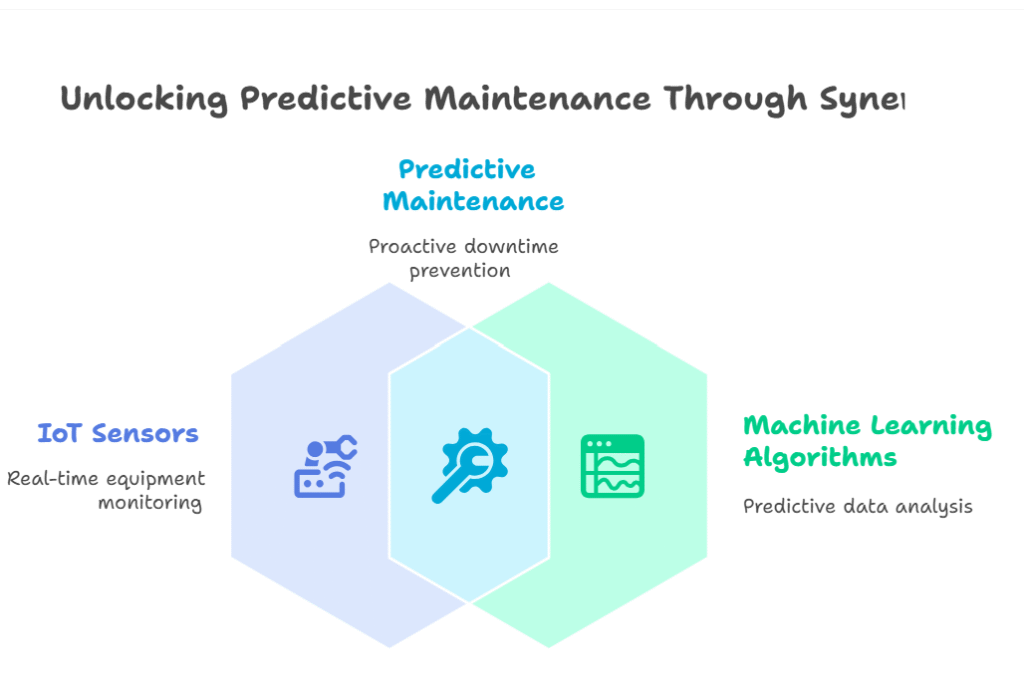lot artificial intelligence they’re usually referring to the massive integration of AI into the Internet of Things (IoT). In simple terms, it’s about using smart algorithms to make sense of the huge amounts of data generated by connected devices—everything from smart thermostats to industrial robots.
But it’s more than just connecting devices. It’s about making those devices intelligent, so they can learn, adapt, and even make decisions on their own. That’s where IoT machine learning comes in.
The Rise of IoT and Machine Learning
Let’s face it: the world is more connected than ever. By 2025, there are billions of IoT devices in homes, factories, hospitals, and cities. But all these devices are only as useful as the data they produce—and that’s where machine learning steps in.
IoT and machine learning work together to turn raw data into actionable insights. For example, a smart factory might use sensors to monitor equipment, then use AI to predict when a machine will need maintenance. This isn’t just convenient—it can save companies millions by preventing downtime.

How Does IoT With Machine Learning Work?
So, how do IoT with machine learning systems actually function? Here’s a simple breakdown:
- Data Collection: IoT devices gather data from the environment—temperature, motion, energy usage, and more.
- Data Transmission: This data is sent to a central hub or the cloud.
- Machine Learning Analysis: AI algorithms analyze the data, looking for patterns, anomalies, or opportunities.
- Action: The system can trigger alerts, automate responses, or even adjust device behavior in real time.
For example, in a smart parking lot, sensors detect available spaces, and AI predicts peak times, helping drivers find spots faster and reducing congestion.
Real-Life Example: AI on the Lot
Let’s look at a real-world scenario. Imagine a large car dealership with hundreds of vehicles on the lot. Traditionally, tracking inventory, monitoring security, and managing test drives was a manual, error-prone process.
Now, with AI on the lot, cameras and sensors track every vehicle’s location, monitor for suspicious activity, and even analyze customer behavior. The result? Fewer lost cars, better security, and a smoother customer experience.
A dealership manager shared, “Since we started using AI on the lot, we’ve cut inventory errors by 90% and improved customer satisfaction. It’s like having an extra set of eyes everywhere.”
The Benefits of Lot Artificial Intelligence
Why are so many industries investing in lot artificial intelligence? Here are some of the biggest advantages:
- Efficiency: Automate routine tasks and free up human workers for higher-value activities.
- Cost Savings: Predictive maintenance and smart resource allocation reduce waste and downtime.
- Safety: AI-powered monitoring can detect hazards and prevent accidents.
- Personalization: Tailor experiences for customers, from smart homes to retail environments.
- Scalability: Easily expand systems as your needs grow.
IoT Machine Learning: The Brains Behind the Operation
At the heart of lot artificial intelligence is IoT machine learning. But what exactly is it?
IoT machine learning refers to the use of AI algorithms to analyze data from connected devices. These algorithms can:
- Detect patterns and trends
- Predict future events
- Automate decision-making
- Continuously improve as more data is collected
For example, a smart thermostat learns your schedule and adjusts the temperature automatically, saving energy and money.
Challenges and Risks of Lot Artificial Intelligence
Of course, no technology is perfect. Here are some challenges to keep in mind:
- Data Privacy: With so much data being collected, protecting user privacy is critical.
- Security: IoT devices can be targets for hackers if not properly secured.
- Complexity: Integrating AI and IoT requires expertise and investment.
- Bias: Machine learning models can reflect biases in the data, leading to unfair outcomes.
It’s important to work with trusted partners and follow best practices to minimize these risks.
IoT and Machine Learning in Different Industries
Let’s explore how IoT and machine learning are transforming various sectors:
Healthcare
Wearable devices monitor patient health, and AI predicts potential issues before they become emergencies.
Manufacturing
Smart factories use sensors and AI to optimize production, reduce downtime, and improve quality.
Retail
Stores track inventory in real time, personalize offers, and analyze customer behavior for better service.
Transportation
AI-powered traffic systems reduce congestion, and smart vehicles improve safety and efficiency.
Agriculture
Sensors monitor soil and weather, and AI helps farmers optimize irrigation and crop yields.
The Future of Lot Artificial Intelligence
What’s next for lot artificial intelligence in 2025 and beyond?
- Edge AI: More processing will happen on devices themselves, reducing latency and improving privacy.
- Self-Healing Systems: AI will detect and fix problems automatically, with minimal human intervention.
- Greater Personalization: Systems will adapt to individual users, creating truly customized experiences.
- Sustainability: AI will help optimize energy use and reduce environmental impact.
How to Get Started With IoT and Machine Learning
Interested in bringing lot artificial intelligence to your business or home? Here’s how to start:
- Identify Opportunities: Look for areas where automation or data analysis could add value.
- Choose the Right Devices: Invest in IoT devices that support AI integration.
- Partner With Experts: Work with companies specializing in IoT and machine learning.
- Focus on Security: Protect your data and devices from cyber threats.
- Start Small: Pilot projects can help you learn and scale up gradually.
Pros and Cons of Lot Artificial Intelligence
Pros
- Increased Efficiency: Automate repetitive tasks and optimize operations.
- Cost Reduction: Lower maintenance and operational costs.
- Improved Safety: Real-time monitoring and alerts.
- Better Decision-Making: Data-driven insights for smarter choices.
Cons
- Upfront Investment: Initial costs can be high.
- Complexity: Requires technical expertise to implement and maintain.
- Privacy Concerns: Sensitive data must be protected.
- Potential Job Displacement: Some roles may be automated.
Real-World User Quote
“I never realized how much data our machines were generating until we started using IoT with machine learning. Now, we catch problems before they happen and save thousands every month.”
FAQs
Q. What is lot artificial intelligence and how does it work?
A. Lot artificial intelligence refers to the integration of AI with IoT devices, allowing them to collect data, learn from it, and make decisions or automate actions. It works by combining sensors, connectivity, and machine learning algorithms.
Q. How does IoT machine learning improve business operations?
A. IoT machine learning analyzes data from connected devices to detect patterns, predict issues, and automate responses. This leads to increased efficiency, reduced costs, and better decision-making.
Q. What are the risks of using AI on the lot?
A. Risks include data privacy concerns, security vulnerabilities, and the potential for biased or inaccurate AI models. It’s important to use secure devices and follow best practices.
Q. How can I start using IoT and machine learning in my company?
A. Begin by identifying areas where automation or data analysis could help. Invest in compatible IoT devices, partner with experts, and start with small pilot projects to learn and scale.
Final Thoughts
In 2025, lot artificial intelligence isn’t just a trend—it’s a fundamental shift in how we interact with technology. By combining the power of IoT machine learning, businesses and individuals can unlock new levels of efficiency, safety, and personalization.
CLICK HERE FOR MORE BLOG POSTS
“In a world of instant takes and AI-generated noise, John Authers writes like a human. His words carry weight—not just from knowledge, but from care. Readers don’t come to him for headlines; they come for meaning. He doesn’t just explain what happened—he helps you understand why it matters. That’s what sets him apart.”

